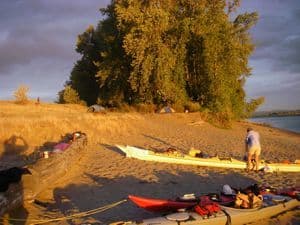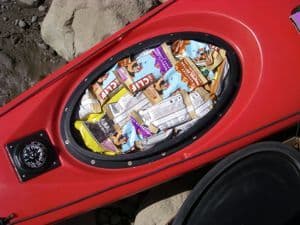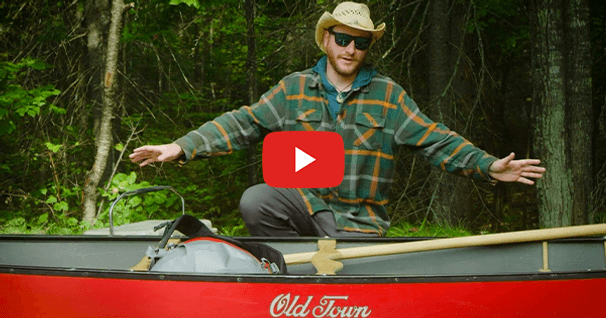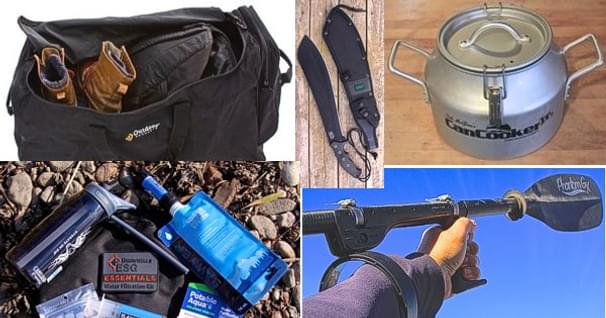Kayak Camping Tips
Kayak camping is not all that different than backpacking - if anything it is easier as you don't have to carry all the weight on your back (unless you are portaging). Much of the same equipment you would use for backpacking also works for kayak camping - but with the added benefit that weight is not as much of an issue. This article is meant to provide some thoughts on how to use your kayak for camping.

Basic Advice for Kayak Camping
There are a few areas where kayak camping is different than backpacking. For example, the boat's hatches are of an interesting shape, and have some limitations on what and how much can be placed in them. It is definitely advisable that you try to load your boat before you head out on your trip to make sure you can fit what you plan to bring.
Also, it is preferable to put heavy items at the bottom of the boat and closer to the cockpit (away from the bow and stern), and keep the weight reasonably well balanced between front-back and left-right.
I am a stickler for not putting items on my deck, unless I need them while paddling. I don't want to look like a yard sale, plus items on the deck add wind resistance and change the balance of the boat. If I can't fit some piece of camp equipment in the hold, I figure out what I can leave behind to make everything I carry fit.
I also try not to have any gear inside the cockpit with me, though have put some at my feet (past my foot pegs) in extreme situations. When I do, I make sure it is things that will float, so I can pick them up in case I wet exit.
Beyond that, here are some specific ideas to consider…
50 years of lightweight, maneuverable, high-performing kayaks.
Check out this interview with Tom Keane, Eddyline Kayaks Co-Owner, on their journey!
Waterproof Hatches... Aren't.
Even if you know you have never seen water in the hatches of your boat, Murphy's Law will find a way to get water in their when you least expect it. There are certain items you would want to keep dry no matter what, and added protection should be used for these in even the driest of boats. These include clothing, sleeping bag, fire starting equipment, first aid kit, etc. And if you are using boat you are not familiar with (such as a rental boat), you should assume the hatches are not waterproof.
Dry bags are an easy and effective way to keep your stuff dry. But they are costly. And most touring or sea kayaks can only fit a limited number of dry bags, especially larger ones. For example, my 17 foot touring kayak can fit 3 medium (~20 liter) dry bags in its hatches. A British style boat of the same length with a skeg (which takes up some space in the rear hatch), would have even less space for bags.
But around these medium dry bags, I can fit many small dry bags and small items. So if you are stocking up on dry bags, get many of the smaller ones along with a few medium ones.
Some tricks to reduce the number of dry bags you need:
- Sleeping bags in stuff sacks can be made water proof by lining the inside of the stuff sack with a heavy duty trash bag before stuffing it. The stuff sack would provide extra abrasion protection to the trash bag, allowing it to stay waterproof under most circumstances (though double bagging may still be a worthwhile preventative step - sleeping in a wet sleeping bag is not a fun experience…).
- Things that don't need to be totally dry can often be placed in trash bags. For example, I often place my tent inside a trash bag.
- Think about whether something even needs to be kept dry. I remove the poles from my tent and place them separately directly in the boat. Being long and skinny, they fit nicely up towards the bow or stern. My sleeping pad is not put in a bag at all - if it gets wet, I can dry it in the sun or with a camp towel.

For items that don't need to be kept dry, it is actually beneficial to place them loose in your boat. Trying to find room for a full food bag can be difficult. But if you remove things that don't need to be kept dry, like canned foods, it is now much easier to find space for a half full bag and the separate cans.
On longer trips, you will find that you have lots of loose items and small bags so that you can pack your boat tightly. This can be inconvenient to load and unload. To help this, it is useful to have a tarp available that you can lay items on just before loading, or as you take items out of your boat. It can also be useful to carry an empty duffel bag, which you use when carrying all these loose items to and from your boat.
Can beats Bottle, Box beats Can
I refuse to eat MREs or freeze dried foods when kayak camping. Ok, I haven't done any super long expeditions yet, but for the trips up to a week without resupply points that I have done, I have been able to eat well without resorting to freeze dried foods.
One general rule is that cans are better than bottles, and boxes are better than cans. Being that you need to carry your garbage out, you can save space by crushing a can down after you empty it, where you would need to carry the bottle back as is.
Boxes are better because many can be burnt safely in your campfire. And in the case of boxed wines, you can take the Mylar bag out of the box and just bring that (the bag is strong, so can withstand a good amount of handling - but also flexible, so fits in odd sized places). Worst case, boxes can also be crushed down just like a can.
Eating Well While Kayak Camping
Of course, people often think of something simple like rice or pastas for camping, but you can go beyond that without too much effort.
Believe it or not, most of my kayak camping trips involve fresh meats and vegetables for the entire trip. It is hard to get extended time off of work, so many of our trips are overnight trips. Frozen meats will take a day or two to defrost, providing an easy way to keep fresh for short trips, or the start of long trips.
Canned meats can be very useful for after when you can't use fresh foods. This includes tuna, ham, chicken, corned beef, etc. These can definitely be used in tacos, stews, soups, pastas, etc. Root vegetables (carrots, onions, yams, potatoes, etc.) keep quite well as is. Beyond that, canned vegetables last a long time and work well in many recipes. Note - it may be advisable to mark with a waterproof marker what the contents of the can are, as labels can come off if they get wet (and you could end up with mystery meals - not knowing what is inside the can you are opening).
Don't forget dried foods. Dried fruits go well as part of trail mix or Gorp. Dried vegetables area also available in some cases - sun dried tomatoes can often be used in place of fresh tomatoes. And dried meats, like jerky, have very long shelf lives.
And if you are paddling in cold water, keeping the perishable foods at the bottom off your boat will help keep them fresh longer.
Of course, you are on the water, so catching fish or harvesting shellfish is another way you can supplement your food supplies. One of the most memorable meals I have had on a kayak trip is Lummi Salmon, where we harvested kelp to wrap around salmon before grilling.
Don't Forget to Drink
The basic rule of a gallon of water per person per day still holds. If you are paddling on fresh water, or on salt water where you can get access to fresh water streams, a water filter is an easy way to keep from having to carry all your water.
But, sometimes you don't have access to fresh water on your trip. One trip I took was a 5-night trip on the small islands in the north of the San Juan Islands of Washington, and we did not have access to water there, so we carried our water with us. Collapsible water containers are pretty much required (hard sided ones are difficult to fit in the boat). Even better are those that are flexible (unlike those plastic water cubes that you often see in camping stores), which will allow them to fit in odd sized shapes. Platypus Water Tank and MSR Dromedary Bags are two options that you can find at most outdoor retailers.
Boxed wines were mentioned earlier. But there is an extra benefit to drinking boxed wines at home (if you can find boxed wines that meet your taste requirements) - the bladders used in boxed wines can be reused as water bags. Drink the wine, and then take the bladder out and clean it up. You now have a 3 liter water bag.
And other drinks are available in Tetra Pak (aseptic packaging), including milk and juices, and stay good for a long time until opened (normal shelf life after opened).
Salt water actually works for many of the duties we normally use fresh water with. We normally clean ourselves and our dishes with salt water (camp suds or similar biodegradable soap for both, and an added soak in a salt water bleach solution for the dishes/utensils).
Final Thoughts
You may find that accessing the far tips of the bow and stern of your boat is difficult. One trick I have heard is to tie a line to the bag you stick the farthest in - then when you want the items from the ends, you pull on this line and that bag will pull any other items at the end out with it.
If you kayak camp often, you will want to come up with some sort of system of different color bags to differentiate contents, and also packing so that the things you need are easiest to access (and those you don't need at that night are left in the boat). But this is a personal preference, and something you will set over time, so best not to worry about this too much on your first trip.
Related Articles
Walker from Old Town shares a quick tip on how to pack a balanced canoe to help ensure better tracking…
Each year the outdoor industry pulls back the curtain to showcase more and more "stuff" for us to drool…
Mark Twain once described the Mississippi River as being "too thick to swim it and too thin to plow!"…
Drying is probably the most ancient way to preserve food for a very long period of time. You have…



